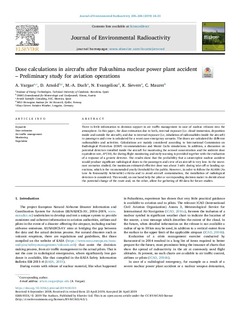| dc.contributor.author | Vargas, Arturo | |
| dc.contributor.author | Arnold, Delia | |
| dc.contributor.author | Duch, M.-A. | |
| dc.contributor.author | Evangeliou, Nikolaos | |
| dc.contributor.author | Sievers, Klaus | |
| dc.date.accessioned | 2019-05-23T08:39:51Z | |
| dc.date.available | 2019-05-23T08:39:51Z | |
| dc.date.created | 2019-05-16T10:20:48Z | |
| dc.date.issued | 2019 | |
| dc.identifier.citation | Journal of Environmental Radioactivity. 2019, 205-206 24-33. | nb_NO |
| dc.identifier.issn | 0265-931X | |
| dc.identifier.uri | http://hdl.handle.net/11250/2598532 | |
| dc.description.abstract | There is little information to decision support in air traffic management in case of nuclear releases into the atmosphere. In this paper, the dose estimation due to both, external exposure (i.e. cloud immersion, deposition inside and outside the aircraft), and due to internal exposure (i.e, inhalation of radionuclides inside the aircraft) to passengers and crew is calculated for a worst-case emergency scenario. The doses are calculated for different radionuclides and activities. Calculations are mainly considered according to International Commission on Radiological Protection (ICRP) recommendations and Monte Carlo simulations. In addition, a discussion on potential detectors installed inside the aircraft for monitoring the aerosol concentration and the ambient dose equivalent rate, H*(10), for during-flight monitoring and early warning is provided together with the evaluation of a response of a generic detector. The results show that the probability that a catastrophic nuclear accident would produce significant radiological doses to the passengers and crew of an aircraft is very low. In the worst-case scenarios studied, the maximum estimated effective dose was about 1 mSv during take-off or landing operations, which is the recommended yearly threshold for the public. However, in order to follow the ALARA (As Low As Reasonably Achievable) criteria and to avoid aircraft contamination, the installation of radiological detectors is considered. This would, on one hand help the pilot or corresponding decision maker to decide about the potential change of the route and, on the other, allow for gathering of 4D data for future studies. | nb_NO |
| dc.language.iso | eng | nb_NO |
| dc.rights | Attribution-NonCommercial-NoDerivatives 4.0 Internasjonal | * |
| dc.rights.uri | http://creativecommons.org/licenses/by-nc-nd/4.0/deed.no | * |
| dc.title | Dose calculations in aircrafts after Fukushima nuclear power plant accident – Preliminary study for aviation operations | nb_NO |
| dc.type | Journal article | nb_NO |
| dc.type | Peer reviewed | nb_NO |
| dc.description.version | publishedVersion | nb_NO |
| dc.rights.holder | © 2019 The Authors. Published by Elsevier Ltd. | nb_NO |
| dc.source.pagenumber | 24-33 | nb_NO |
| dc.source.volume | 205-206 | nb_NO |
| dc.source.journal | Journal of Environmental Radioactivity | nb_NO |
| dc.identifier.doi | 10.1016/j.jenvrad.2019.04.013 | |
| dc.identifier.cristin | 1698261 | |
| dc.relation.project | EC/H2020/723986 | nb_NO |
| cristin.unitcode | 7460,57,0,0 | |
| cristin.unitname | Atmosfære og klima | |
| cristin.ispublished | true | |
| cristin.fulltext | original | |
| cristin.qualitycode | 1 | |

